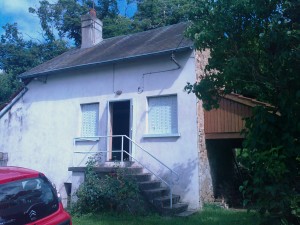Notes from Living in the Morvan: Our Region’s Heritage: Guide to Renovation and Construction
Recommends for serious reading Marcel Vigreux’s Paysans et notables en Morvan au XiXth siecle jusqu’en 1914 “that gives us the keys to understand the men and the architecture of the Morvan at its zenith, the period when many of its homes were built”.
Suggests a typical farm of mid to late 1800s – couple, four children, who raise a cow, a pig, two goats, some rabbits, chicken and guinea fowl and on three acres grows rye, oats, buckwheat, potatoes and help, depending on the year. Has apple trees and beside them keeps bees. Man also works odd jobs, including floating logs on the river (which no doubt left the wife doing the bulk of the farm work. On the “ouche” (common garden?) everyone grows potatoes, and vegetable garden is women’s preserve.
Since them has been a “closure” of the landscape – with the abandonment of arable land and the integration of conifers into hardwood forest.
Houses are “often turned away from the North wing and the hard rain of the West”.
Arene is decomposed granite that is almost like sand. It is used mixed with clay soil or lime to make mortar.
A day labourer’s cottage would be just one room, originally houses had a thatched roof (chaume), so they came to be known as chaumiere.
A small farmer would have a block type house, with the cottage attached to a barn and cowshed.
Usually there would be 2 to 10 hectares of land with it.
The six-pane window is typical of most historic Morvan architecture, with a short lintel for economy. The model is of a man standing up to look out, but even seated the one meter high breast wall allows a view. Ideally the surround is dressed stone, or otherwise roughened concrete imitating this. (Village houses or mansions demonstrate they are showier with eight-pain windows.)
Normally there are very few openings in the gables – if inserting should be approached in the spirit of hayloft doors or aeration gaps “trous de chouan” – nesting spots for the barred owl.)
Shutters should have two crossbars and a top rail. Not – it is stressed diagonal “Z” braces in a colour that contrasts with the wood. They must be painted.
Inserting wall dormers – mistakes to avoid include one that is wider than high, making a shed dormer (imported from eastern France) and a skylight (Velux) larger than 78x98cm or in a horizontal format.
Traditional low bushy hedges – fly honeysuckle, common dogwood, raspberry bush, whortleberry, “toujours vert” rose tree, round-ear willow, common privet, wayfaring tree.
Traditional trimmed hedges – hawthorn, box, common oak, pedunculate oak, hornbeam, barberry, hedge maple, gooseberry bush, holly, yew, common privet, beech.
“White is not typically Morvan.” The tones of limes and local sands go well with a range of colours from green-grey to blue-grey. Also can use golden beige and greige “warm beige”.
Declaration de travaux (Declaration of building alterations) for small projects that do not create floor space, or that create a space less than 20m square. Need three copies with a map of the area, scale 1:5000 to 1:25,000, a dimensional site map on scale 1:200 to 1:500. Drawings, sections and facade drawings, scale 1:100 to 1:50. Photographs.
Expect a response in one month, or two months if there is a need for external consultations.
(When this book was printed anyway, free consultations with architects at the Parc du Morvan, Saint-Brisson, www.parcdumorvan.org.)
Why you wonder, the interest, well this is now my new “maison de vacance”…

… one room, literally, at the moment, but the good news is the 50s woodfired cooker and chimney seems to work fine, its pretty cosy. The bad – well there’s a fine crop of stinging nettles in the garden, and I haven’t tackled the attic yet, likely to be filled with some unpleasant items, judging on what was in the house…
And the Morvan looks lovely now – stand by for an “autumn colours” picture post.


 About
About